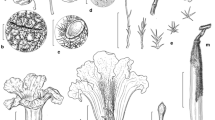Abstract
Parasenecio auriculata is a woodland perennial herb widely distributed in Northeastern Asia, constituted by a poorly understood polyploidy with a diploid (2n=2x=60) and a tetraploid (2n=4x=120). In this study, for a better understanding of the polyploidal evolution, cytogeography and morphological variation were analyzed in Japanese P. auriculata, including two varieties; var. bulbifera endemic to central Hokkaido and var. kamtschatica widely distributed in northern Honshu and Hokkaido. The occurrence of two polyploidal levels was reconfirmed. While var. bulbifera is predominantly tetraploid, var. kamtschatica is comprised of diploid and tetraploid. Morphological variation among 22 quantitative characteristics is continuous and not distinctive among cytotypes or varieties, but plant size tended to be larger in the order, diploid of var. kamtschatica, var. bulbifera, and tetraploid of var. kamtschatica. The cytotype distribution showed a conspicuous geographical pattern. Besides var. bulbifera endemic to the central Hokkaido, the diploid of var. kamtschatica is mainly found in Southern Hokkaido, and the tetraploid has a disjunct distribution in eastern and northern Hokkaido and northern Honshu. Such a geographical pattern is possibly attributable to the differentiation of climatic preference among cytotypes and varieties, and may have been established in association with the climatic cline along the Japanese archipelago.






Similar content being viewed by others
References
Arano H (1964) Cytological studies in Subfamily Carduoideae (Compositae) of Japan XVII. The Karyotype analysis in Cacalia and Syneilesis. Bot Mag Tokyo 77:86–97 (In Japanese)
Gauthier P, Lumaret R, Bédécarrats A (1998) Genetic variation and gene flow in Alpine diploid and tetraploid populations of Lotus (L. alpinus (D.C.) Schleicher/L. corniculatus L.). I. Insights from morphological and allozyme markers. Heredity 80:683–693
Grant V (1981) Plant speciation, 2nd edn. Columbia University Press, NY
Japan Metrologial Agency (2002) Mesh climatic data of Japan. Japan Metrologial Business Support Center, Tokyo (in Japanese; CD-ROM)
Kira T (1948) On the altitudinal arrangement of climatic zones in Japan. A contribution to the rational land utilization in cool highlands. Agric Sci N Temp Reg 2:143–173
Kira T, Shidei T, Numata M, Yoda K (1967) Vegetation of Japan. Science (Tokyo/Kagaku) 46:235–247 (in Japanese)
Kitamura S (1942) Compositae Japonicae IIIb:209–212
Koyama H (1961) Chromosome numbers in some Japanese species of Cacalia and the allied genera. Acta Phytotax Geobot 19:18–19 (in Japanese)
Koyama H (1966) Cytotaxonomic studies of Compositae. 2. On Cacalia auriculata var. kamtschatica. Acta Phytotax Geobot 22:11–14
Koyama H (1995) Parasenecio. In: Iwatsuki K, Yamazaki T, Boufford DE, Ohba H (eds) Flora of Japan III. Kodansha, Tokyo, pp 47–53
Koyama H, Fukuoka N, Kurosaki N (1971) Taxonomical and geographic studies on the Japan-Sea side elements. I. On the northern species (Sympetalae). Mem Natl Sci Mus (Tokyo) 4:87–94 (in Japanese)
Levin DA (1983) Polyploidy and novelty in flowering plants. Am Nat 122:1–25
Levin DA (2002) The role of chromosome change in plant evolution. Oxford University Press, NY
Masuda H (1972) Tree distribution and temperature factor. Natural distribution of Hokkaido native coniferous trees and warmth index. Jpn J For Environ 8:7–16 (in Japanese)
Miyawaki A (1977) Vegetation of Japan—compared with other region of world. Gakken, Tokyo
Mosquin T (1967) Evidence for autopolyploidy in Epilobium angustifoloium (Onagraceae). Evolution 21:713–719
Naiki A, Nagamasu H (2004) Correlation between distyly and ploidy level in Damnacnathus (Rubiaceae). Am J Bot 91:664–671
Nishikawa T (1980) Chromosome counts of flowering plants of Hokkaido (4). Rep Taisetsuzan Inst Sci 15:23–28 (in Japanese)
Nishikawa T (1982) Chromosome counts of flowering plants of Hokkaido (6). Rep Taisetsuzan Inst Sci 17:9–16 (in Japanese)
Nishikawa T (1984) Chromosome counts of flowering plants of Hokkaido (7). J Hokkaido Univ Educ (Ser IIB) 35:31–42 (in Japanese)
Nogami M, Ohba H (1991) Warmth index and vegetation of Japan. Science (Tokyo/Kagaku) 61:136–149 (in Japanese)
Otte SP, Whitton J (2000) Polyploid incidence and evolution. Annu Rev Genet 34:401–437
Richards AJ (1997) Plant breeding systems, 2nd edn. Chapman and Hall, London
Robinson H, Carr GD, King RM, Powell AM (1997) Chromosome numbers in Compositae. XVII: Senecioneae III. Ann MO Bot Gard 84:893–906
Sakai A, Kurahashi A (1975) Freezing resistance of conifers in Japan with special reference to their distributions. Jpn J Ecol 25:192–200 (in Japanese)
Sokal RR, Rohlf FJ (1995) Biometry, 3rd edn. Freeman, NY
Sokolovskaya AP (1960) Georaficheskoje rasprostranenie poliploidnykh vidov rastenii (issledovanije flory o.Sakhalin). Vestn Leningrodsk Univ No. 4 Ser Biol 21:42–58 (in Russian)
Sokolovskaya AP (1966) Georaficheskoje rasprostranenie poliploidnykh vidov rastenii (issledovanije flory Primorskogo Kraya). Vestn Leningrodsk Univ No. 3 Ser Biol 1:92–106 (in Russian)
Sokolovskaya AP (1968) A karyological investigation of the flora of the Koriakian land. Bot Zhul 53:99–105 (in Russian)
Tatewaki M (1955) Pan-mixed forest zone in East Asia. N For 7:240–243
Uemura S, Takeda Y, Nakanishi S (1986) Behaviors of the main temperate plant in Hokkaido along climatic gradients. Jpn J Ecol 36:141–152
Zar JH (1999) Biostatistical analysis, 4th edn. Prentice Hall, NJ
Acknowledgements
The author thanks the staff of the botanical garden of the Graduate school of Science, Kyoto University for their support in the cultivation of plant materials; and Dr. J. Noguchi (Kyoto University) and Dr. Y. Kimoto (Research Institute for Humanity and Nature) for technical advice on chromosome observations.
Author information
Authors and Affiliations
Corresponding author
Rights and permissions
About this article
Cite this article
Nakagawa, M. Ploidy, geographical distribution and morphological differentiation of Parasenecio auriculata (Senecioneae; Asteraceae) in Japan. J Plant Res 119, 51–61 (2006). https://doi.org/10.1007/s10265-005-0239-x
Received:
Accepted:
Published:
Issue Date:
DOI: https://doi.org/10.1007/s10265-005-0239-x




